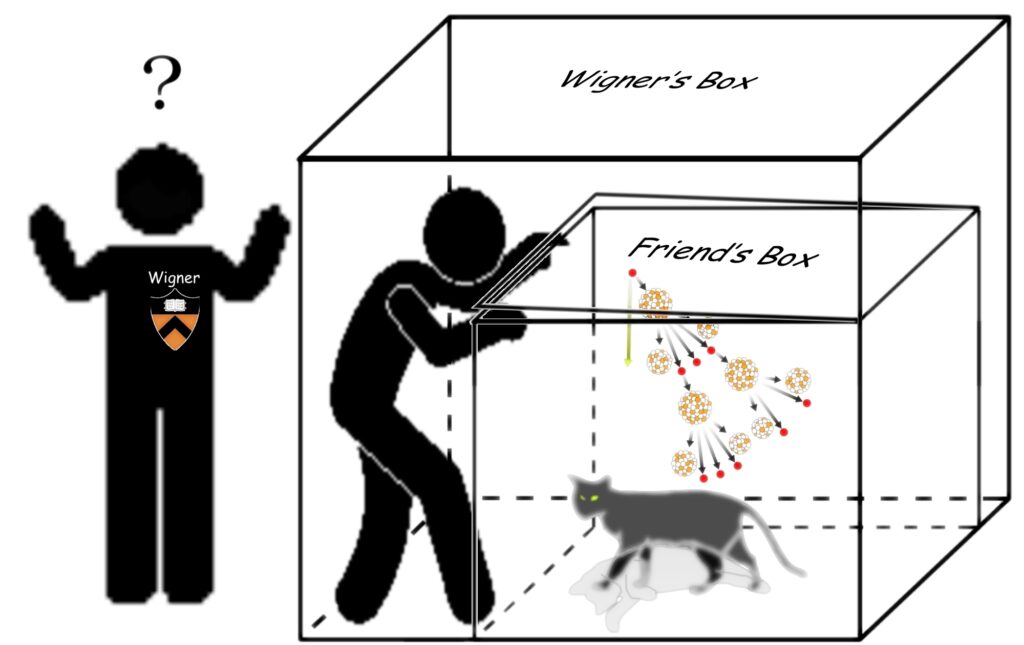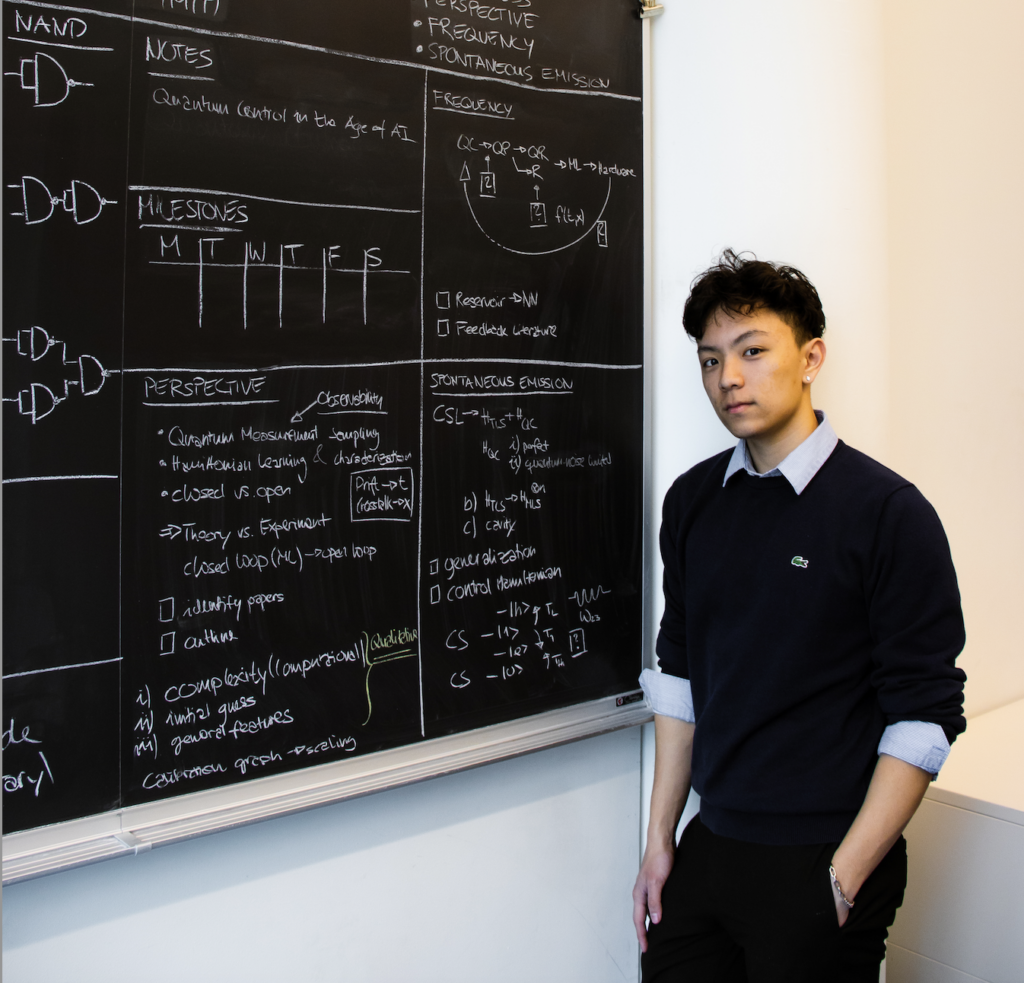Quantum Bootcamp Part III: Eugene Wigner, His Friend(s), and a Quantum Princeton
The recent release of the movie “Oppenheimer” provides an opportunity for us in this, the third in our series of Quantum Bootcamp columns (here are columns One and Two), to discuss a bit of the history of quantum physics and Princeton University’s role in it. Let me take you on a brief journey from the edge of research on quantum mechanics and its still-debated philosophical questions—i.e. Wigner’s Friend—back to its foundational physicists who made Princeton a hotbed of quantum mechanics.
We can start with the phenomenon of “Wigner’s Friend.” Wigner’s Friend is a thought experiment in theoretical quantum physics first conceived in 1961 by physicist Eugene Wigner, a former professor at Princeton University and winner in 1963 of the Nobel Prize in Physics. In his thought experiment, one person, “the friend,” is in a laboratory performing some sort of quantum mechanical measurement while “Wigner” is outside the lab and has no way of knowing the result of the experiment.
Say the measurement is of a quantum mechanical spin system whose possible eigenvalues are 0 or 1. In accordance with quantum principles, once the friend within the lab makes the measurement, the superposition state has collapsed into one of the eigenvalues; so it is now either 0 or 1. For Wigner, however, who still has no clue what the result of the experiment is, the system must be described as an entangled state represented by a wave function of probabilities, where the laboratory system including the friend are incorporated with the measurement itself.
In this way, a natural problem arises—which is the objectively correct perspective that describes the system: the friend’s, or Wigner’s? In the formulation of both of these descriptions, there are no direct errors, yet they seem to represent two different realities. In fact, it turns out that there is no objective reality, in the same way that Bell’s Theorem disavows the idea of objective values existing absent of quantum measurements.

Suppose a cat is enclosed in a box with a Uranium atom and a stray neutron in this modified version of the Schrödinger's Cat paradox. If the neutron atom hits the Uranium atom, the resulting chain reaction and radioactive radiation lead to the cat's death. To a person outside the box, the cat's condition is represented as a superposition of the neutron bouncing around—the cat is alive—and the chain reaction starting—the cat died. A sneak peek inside the box leads to the superposition's collapse and clarifies the cat's status. Suppose another box—Wigner's box—encloses Wigner's Friend and the cat's box. While Wigner's Friend clarified the state of the cat's wellbeing, Wigner's knowledge remains limited to a superposition of the cat being alive and dead.
Before we move on, let’s offer a quick explanation of Bell’s Theorem, and why it was the basis of the 2022 Nobel Prize in Physics. The experimental violation of Bell’s Theorem indicated that, contrary to the initial intuition of many physicists, there are in fact no “hidden variables” that determine the measurement outcomes of quantum systems ahead of a measurement. Therefore, measuring one part of an entangled pair instantaneously defines the future measurement result of its counterpart—which could even be hundreds of lightyears away—without communication and without the outcome being defined during the entanglement creation.
This phenomenon was so puzzling and irritating that Einstein famously referred to it in 1935 as “spooky action at a distance.”
The conclusion in the context of the Wigner’s Friend thought experiment is that between the two spaces of reality that Wigner and his friend inhabit, there is only a consistent objective reality for each of them in their self-contained realities, but no universal one. As unsatisfying as it might be, it was reliably determined by application of Bell’s Theorem itself along with photon experimentation on multiple “friends” and “Wigners.”
That being said, the hypothetical represents a quantum mechanical research front that is still far from settled. And while we were writing and researching for this article, a certain movie got us thinking in a deeper way about Wigner, his time at Princeton, and his ties to the atomic bomb.
That movie, of course, was “Oppenheimer,” which not only depicted foundational physicists like Niels Bohr, Werner Heisenberg, and Albert Einstein, but also featured a brief scene actually filmed on Princeton’s campus.
As the film makes clear, J. Robert Oppenheimer had deep ties to Princeton and to the Institute for Advanced Study. He was the third director of the Institute from 1947 to 1966. When he took up the position, the faculty rank comprised Einstein, John von Neumann, and Hermann Weyl, among others. Oppenheimer’s reputation and network enabled him to convince several more thought leaders to join the efforts at Princeton. His funeral was even held on Princeton’s campus at Alexander Hall.

Column series author Ethan Wang ’26 who, under the tutelage of the Department of Chemistry Postdoc Benjamin Lienhard of the Rabitz Group, has been learning quantum computing in his spare time.
Princeton itself has not only been the source of prominent quantum philosophical developments such as the many worlds theory, but also to fundamental quantum physicists Wigner and von Neumann around the same time, both of whom, along with Teller, were Hungarian.
Kinship amongst physicists extended beyond location and scientific collaboration, since Wigner’s sister would later marry Paul Dirac, the inventor of the famous Dirac notation for quantum mechanics. It is amazing to note the many ways in which these physicists crossed paths and found each other again and again, lending credence to the idea of entanglement in more ways than one. Together, these physicists laid the groundwork for the field of quantum mechanics. We have them to thank for the fact that quantum computing has grown into a field of its own.
Today, there are even calls for another “Quantum Oppenheimer” in the quantum computing race. Putting aside the irony that Oppenheimer was already famously a quantum physicist, such statements show that the Manhattan Project represents not just a pinnacle of science, but one of military power and geopolitics.
For those who want to explore the concept of Wigner’s Friend further, here is a link to an article in Nature Reviews Physics published last year.
In our next column, we’ll return to a traditional “classroom” structure to discuss puzzling and exciting elements of quantum mechanics, which we learned about in our spare time this summer.
